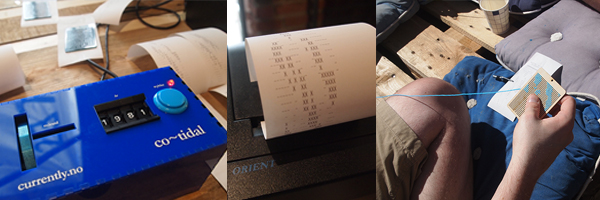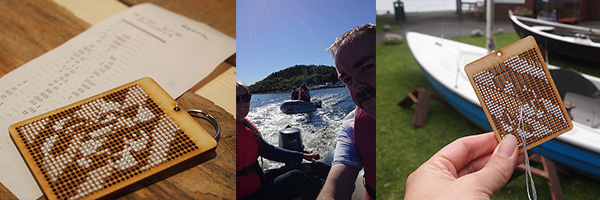
Last month I spent 3 days in Oslo for the latest event of the ongoing Currently project which I initiated with artist and curator Amanda Steggell back in 2012. If I Were The Ocean is Amanda’s biggest public exhibition for the project to date and builds on four years of research with a growing network of artists.
Currently has been one of the most challenging and rewarding projects I think I have ever been part of and over the years I’ve met many Norwegian artists and friends that I have grown to respect and believe in their work. I’ve also been lucky enough to involve many UK artists and other creative peers in the project who make some of the most exciting technology led work in the UK.
We’ve worked directly with Steve Symons, John O’Shea, Simon Derwent, Jana Winderen, Hillevi Munthe, Adrian McEwen, Gemma May Latham and involved the advice, expertise and component source of the National Oceanographic Centre, Octopus Collective, Natural England, Simon of SeaLevel Research, Cefn Hoile of Shrimping.it, PointFive architects and worked with hosts STATIC, OggCamp2013 and National Museums Liverpool and more recently the Norwegian Maritime Museum.
Originally we envisioned Currently as a single epic sea and freshwater journey trawling for folk tales, stories, experiences, images, salt and fresh water data, AIS ship paths and artistic meta data across the shelf sea between Oslo and Liverpool in something called the GhostNet. Over four years and 2 hackweekends in Oslo and Liverpool supported by the Norwegian Arts Council, Currently has evolved into an ongoing collaboration across a loosely distributed network of artists, engineers, computer scientists, boat builders and sailors.
Building on these hackdays network member, sailor & project artist Elizabeth Weihe sailed to the UK/Norway twice while Amanda and I developed a range of open source tools and workshops in the UK and Norway while other members developed artistic processes independently. So not a single journey, but an epic one nonetheless.
And the GhostNet along the lines of the original vision was ultimately never built beyond prototype: instead the diverse activity we have developed and delivered over the project period has collected the flotsam and jetsam of data the net was always meant to collect; but in a way that is free from a single physical journey and larger spectacle based events. Instead it’s become a GhostNetwork, with many nodes contributing independently and in forms of pop-up workshops with a variety of partners. The GhostNet referred to fishing nets lost at sea that continue to ‘fish’, ultimately the ShrimpCraft project using the excellent kits at Shrimping.it continues to make people think about water based data and how they can interpret it, something the Co~Tidal project tries to move forward.
Currently has generated along the way:
- Elizabeth Weihe’s journey across the sea,
- stories of the relationship between the UK and Norway,
- Water samples that generate sea-salt-crystal paintings,
- conversations and lectures,
- shipAIS pathways,
- photographs,
- Experimental Workshops and tools for the water curious across the UK and Norway
- Tools for the tidal curious
- A design and prototype for a floating sound installation,
- traditional open-source soap.
- If I Were The Ocean exhibition week, Oslo, Norway
All of this work was presented as thought provoking accessible activity to the public in a range of coastal and land locked settings at a range of scales, and stages of development. It’s for sure generated some long standing working relationships rare for the often high project turnover artists are encouraged to do, in the UK at least. Like any good sea journey preperation is key and although we have not made this single journey we have nevertheless achieved our objectives; using artistic research to communicate and articulate the human relationship to the sea through journeys by sea land and air to workshops in Barrow, Liverpool, Sheffield, Bergen and Oslo
If I Were The Ocean was the first major public exhibition, programme of activity and new work based on this four years of research: and in many ways it was like Currently had tipped it’s GhostNet out on the ‘dock’ of the Maritime Museum for the public to see and the extent of the ‘catch’ was suddenly vast.
This time round on the UK side I worked with Adrian McEwen and Gemma May Latham to develop the Co~Tidal project, a system for generating simple patterns made from traditional Norwegian embroidery and Tidal Height data from a buoy in Oslo harbour generated from the exhibition visitor’s birth date.
Like many things this idea started from a conversation with Cefn Hoile while packing up at Liverpool MakeFest 2016 about how he was looking at making some kind of Tidal Clock kit based on real local tide data for Shrimping.it.
We didn’t quite realise this or have had chance to work much further on that yet; maybe for the next Currently hackday! We did source a cheap peristaltic pump powered by DC motor and have made an openSCAD model for a 3d printed bouy to float inside some transparent tubing to visualise ‘live’ tide data. We brought this along to If I Were The Ocean. Unfortunately, we were so preoccupied with Co~Tidal and our embroidery we did not get to prototyping at the exhibition which was the original plan or work with Cefn futher yet.
Like ShrimpCraft Co-Tidal uses simple largely open source tools to engage people with the Data Literacy I talk about alot but applying this literacy to the context and awareness of the human connection to the sea.
Amanda’s title If I Were the Ocean has been chosen carefully; where the abstracted GhostNet idea fitted with current trends in artistic practice that used data-visualisation, what has always really mattered most to Currently was to tell a contemporary human story. I believe we can harnass the vast sea of marine data to discover things and forensically reveal environmental issues and hidden marine histories; but how to make that data matter to people so it’s part of their identity and their experience and even their hands and hearts is a different thing. I think If I Were the Ocean attempts to place your identity and the work presented invited you to make, smell, see, talk and experience the physical material of the sea.

Our response to If I Were The Ocean was to make something that would make even the most easily accessible and simple marine data meaningful in some way. Adrian known for his work in the internet of things but often not his knowledge of folk music, reminded me of how the structure of Sea Shanty’s reflected actual processes at sea and in researching Co-Tidal we wondered about embroidery and knitting patterns like the ‘Arran’ knit and how they in some way represent the sea, the coastline or a journey.
Gemma May Lathams work investigating the ‘act of making’ and Flow and how that affects our engagement and knowledge made sense here; we are used to standard ways of reading digital information; a graph on a screen etc but what if you had to make the graph? And not just draw it but embroider it? Drawing is often something people perceive as hard and requiring a good deal of knowledge and certainly a degree of confidence, but I think embroidery somehow taps into a deeper domestic memory of making that’s a part of our identity.
I’ve tried to make clear when talking about Domestic Science that the domestic is not a negative term, although perhaps it is often used that way; home and how we live and thrive there is fundamental to human happiness and in some ways Currently reminds us that the sea is not just a place between: it’s a way of life and the real home of many who live on the coast and depend on it.
So we decided we could get people to make some data visualisation based on their own identity; and as something to start with, something everyone has and knows from the earliest age and that we could get from them with the most basic of language: their birthdate.
We built an interface for the public to dial in their month and year of birth, and print out the timings of high and low tides from World Tides and then embroider patterns or Tidal Glyphs to represent this data, the data disrupting a standard Norwegian knitting pattern encoded into the same asci data frame. The ‘act of making’ became something that focussed the visitor and gave them a reason to hang around and talk about the sea, where they were from in Norway, what marine data is and what Currently is and to spend time in the If I Were the Ocean space.
We all know the game of the standard art/museum exhibition. You look, you read, you digest, if someone is there you engage; but careful! not too much; you don’t want to waste a strangers time: you don’t know them after all. Co-Tidal, Amanda’s soap making workshop and the delicate salt crystals of Elizabeth’s paintings based on her water samples from journeys to the UK, the boat trips and readings all disrupted the standard exhibition model so you not so much wanted to stay, but felt able to.
And as usual when making gets you into that ‘zone’ you communicate differently, you relax as the focus unconsciously gives you permission to stay in one place and talk. I learnt more from gallery visitors than most exhibitions that weekend and it reminded me of the kind of conversations we had with the Build Your Own Project with DoES Liverpool and when making our ShrimpCraft kits, although assembling a breadboard arduino is not quite the tribal memory embroidery seems to be, at least, not yet.
As always with Currently the experience by the sea and thinking about it inspired me no end. All 3 of us UK artists said we felt we got something out of it we did not realise we needed and it’s unclear where this latest research will lead us.
Perhaps a vision for the Mersey Estuary? Could we replace quad-bike obsessed teens to help out at the docks on open-source jet skis? Does everything coastal have to be tourism? Can scousers live on and for the water again?
The first Currenlty hackday used the Open Source Swan Pedalo in a giant indoor temporary swimming pool as inspiration to focus the artist’s attention to the water. Like Currently, The swan pedalo project attempted to give people, artists or otherwise, the tools and platforms to engage with waterways using something familiar to even the most land locked of people.
If I Were The Ocean is the culmination of everything from that first pedalo journey and it is indeed an epic and diverse one. It reveals just how inspiring the sea is: to ignore it and not experience something of the material that makes up most of the planet and keeps us alive in so many ways then you’re missing something really human.
That many of us may have lost their connections to seafaring and river faring culture or the waterways under our noses and under our motorways is a real shame.
The Currently project will continue with some care, some making, some thinking and some contact with seawater or freshwater to make these connections come alive, and the GhostNet-work will carry on trawling long after If I Were The Ocean exhibition ends and it’s modular exhibition stands of reclaimed pallettes end up distributed around Oslo’s harbours, marinas and moorings.
